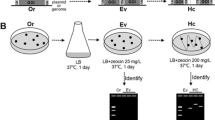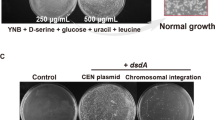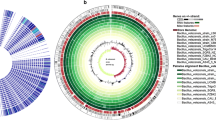Abstract
The Burkholderia pyrrocinia Lyc2 strain isolated from healthy plant rhizosphere showed significant antimicrobial activities against a variety of plant pathogens. In this study, a random mutation library was constructed using an EZ-Tn5 transposome kit and Erwinia amylovora was used as an indicator to screen for mutants with defective antibacterial activity. The transposon gene was verified in the chromosome of the Lyc2 strain using polymerase chain reaction (PCR). The gene that was disrupted by transposon was amplified by rescue cloning for functional and bioinformatics analyses. Antibacterial analysis indicated that the mutant Lyc2-MT2918 was defective in antibacterial activity. Sequence alignment of the mutant suggested that the disrupted gene Glu-2918 was homologous to the glutathione (GSH) synthase gene Bamb-2918 of strain B. ambifaria AMMD. Genetic functional analysis and complementary assay of the disrupted gene, which was predicted to encode GSH synthase, indicated the essential role of the Glu-2918 gene in the antibacterial activity of strain Lyc2.



Similar content being viewed by others
References
Burkholder WH (1950) Sour skin, a bacterial rot of onion bulbs. Phytopathology 40:115–117
Peeters C, Zlosnik JEA, Spilker T, Hird TJ, LiPuma JJ, Vandamme P (2013) Burkholderia pseudomultivorans sp. nov., a novel Burkholderia cepacia complex species from human respiratory samples and the rhizosphere. Syst Appl Microbiol 36:483–489
Vandamme P, Dawyndt P (2011) Classification and identification of the Burkholderia cepacia complex: past, present and future. Syst Appl Microbiol 34:87–95
Caballero-Mellado J, Martinez-Aguilar L, Paredes-Valdez G, Santos PE (2004) Burkholderia unamae sp. nov., an N2-fixing rhizospheric and endophytic species. Int J Syst Evol Microbiol 54:1165–1172
Leahy JG, Byrne AM, Olsen RH (1996) Comparison of factors influencing trichloroethylene degradation by toluene-oxidizing bacteria. Appl Environ Microbiol 62:825–833
Zuniga A, Poupin MJ, Donoso R, Ledger T, Guiliani N, Gutierrez RA, Gonzalez B (2013) Quorum sensing and indole-3-acetic acid degradation play a role in colonization and plant growth promotion of Arabidopsis thaliana by Burkholderia phytofirmans PsJN. Mol Plant Microbe Interact 26:546–553
Bernabeu PR, Pistorio M, Torres-Tejerizo G, Estrada-De los Santos P, Galar ML, Boiardi JL, Luna MF (2015) Colonization and plant growth-promotion of tomato by Burkholderia tropica. Sci Hortic 191:113–120
Song D, Chen G, Liu S, Khaskheli MA, Wu L (2019) Complete genome sequence of Burkholderia sp. JP2-270, a rhizosphere isolate of rice with antifungal activity against Rhizoctonia solani. Microb Pathog 127:1–6
Kim H, Ok Rim S, Bae H (2019) Antimicrobial potential of metabolites extracted from ginseng bacterial endophyte Burkholderia stabilis against ginseng pathogens. Biol Control 128:24–30
Darling P, Chan M, Cox AD, Sokol PA (1998) Siderophore production by cystic fibrosis isolates of Burkholderia cepacia. Infect Immun 66:874–877
Köthe M, Antl M, Huber B, Stoecker K, Ebrecht D, Steinmetz I, Eberl L (2003) Killing of Caenorhabditis elegans by Burkholderia cepacia is controlled by the cep quorum-sensing system. Cell Microbiol 5:343–351
Lu SE, Novak J, Austin FW, Gu G, Ellis D, Kirk M, Wilson-Stanford S, Tonelli M, Smith L (2009) Occidiofungin, a unique antifungal glycopeptide produced by a strain of Burkholderia contaminans. Biochemistry 48:8312–8321
Vellasamy KM, Vasu C, Puthucheary SD, Vadivelu J (2009) Comparative analysis of extracellular enzymes and virulence exhibited by Burkholderia pseudomallei from different sources. Microb Pathog 47:111–117
Chiarini L, Bevivino A, Dalmastri C, Tabacchioni S, Visca P (2006) Burkholderia cepacia complex species: health hazards and biotechnological potential. Trends Microbiol 14:277–286
Kim S, Lowman S, Hou G, Nowak J, Flinn B, Mei C (2012) Growth promotion and colonization of switchgrass (Panicum virgatum) cv. Alamo by bacterial endophyte Burkholderia phytofirmans strain PsJN. Biotechnol Biofuels 5:37
Azura Azami N, Ira Aryani W, Aik-Hong T, Amirul AA (2019) Purification and characterization of new bio-plastic degrading enzyme from Burkholderia cepacia DP1. Protein Expr Purif 155:35–42
Abe M, Nakazawa T (1994) Characterization of hemolytic and antifungal substance, cepalycin, from Pseudomonas cepacia. Microbiol Immunol 38:1–9
Jayaswal R, Fernandez M, Upadhyay R, Visintin L, Kurz M, Webb J, Rinehart K (1993) Antagonism of Pseudomonas cepacia against phytopathogenic fungi. Curr Microbiol 26:17–22
Meyers E, Bisacchi G, Dean L, Liu W, Minassian B, Slusarchyk D, Sykes R, Tanaka S, Trejo W (1987) Xylocandin: a new complex of antifungal peptides. I. Taxonomy, isolation and biological activity. J Antibiot 40:1515–1519
Wang XQ, Liu AX, Guerrero A, Liu J, Yu XQ, Deng P, Ma L, Baird SM, Smith L, Li XD, Lu SE (2016) Occidiofungin is an important component responsible for the antifungal activity of Burkholderia pyrrocinia strain Lyc2. J Appl Microbiol 120:607–618
Yu XQ, Xi LJ, Liu YG, Li GW, Lan YF, Zhu XP, Li XD (2007) Physio-biochemical characterization and molecular identification of Burkholderia cepacia isolate Lyc2 as a PGPR to cotton seedlings. Acta Phytopathol Sinica 37:426–432
Wang X-Q, Showmaker KC, Yu X-Q, Bi T, Hsu C-Y, Baird SM, Peterson DG, Li X-D, Lu S-E (2014) Draft genome sequence of Burkholderia pyrrocinia Lyc2, a biological control strain that can suppress multiple plant microbial pathogens. Genome Announc 2:e00991-14
Vidaver AK (1967) Synthetic and complex media for the rapid detection of fluorescence of phytopathogenic pseudomonads: effect of the carbon source. Appl Microbiol 15:1523–1524
Gross D, DeVay J (1977) Population dynamics and pathogenesis of Pseudomonas syringae in maize and cowpea in relation to the in vitro production of syringomycin. Phytopathology 67:475–483
Solovyev V, Salamov A (2011) Automatic annotation of microbial genomes and metagenomic sequences. In: Li RW (ed) Metagenomics and its applications in agriculture, biomedicine and environmental studies. Nova Science Publishers, Hauppauge, pp 61–68
Hall T (2004) BioEdit version 7.0. 0. Distributed by the author, http://www.mbio.ncsu.edu/BioEdit/bioedit.html
Lefebre MD, Valvano MA (2002) Construction and evaluation of plasmid vectors optimized for constitutive and regulated gene expression in Burkholderia cepacia complex isolates. Appl Environ Microbiol 68:5956–5964
Baysse C, Matthijs S, Pattery T, Cornelis P (2001) Impact of mutations in hemA and hemH genes on pyoverdine production by Pseudomonas fluorescens ATCC17400. FEMS Microbiol Lett 205:57–63
Xu J, Deng P, Showmaker KC, Wang H, Baird SM, Lu SE (2014) The pqqC gene is essential for antifungal activity of Pseudomonas kilonensis JX22 against Fusarium oxysporum f. sp. lycopersici. FEMS Microbiol Lett 353:98–105
Gu G, Smith L, Liu A, Lu SE (2011) Genetic and biochemical map for the biosynthesis of occidiofungin, an antifungal produced by Burkholderia contaminans strain MS14. Appl Environ Microbiol 77:6189–6198
Forman HJ, Dickinson DA (2003) Oxidative signaling and glutathione synthesis. BioFactors 17:1–12
Wade DS, Calfee MW, Rocha ER, Ling EA, Engstrom E, Coleman JP, Pesci EC (2005) Regulation of Pseudomonas quinolone signal synthesis in Pseudomonas aeruginosa. J Bacteriol 187:4372–4380
Almar M, Otero L, Santos C, Gallego JG (1998) Liver glutathione content and glutathione-dependent enzymes of two species of freshwater fish as bioindicators of chemical pollution. J Environ Sci Health Part B 33:769–783
Sharma A, Paul A, Parida S, Pattanayak S, Mohapatra A, Rajesh Kumar P, Sahoo MK, Sundaray JK, Sahoo PK (2018) Dynamics of expression of antibacterial and antioxidant defence genes in Indian major carp, Labeo rohita in response to Aeromonas hydrophila infection. Microb Pathog 125:108–115
Wang Y, Li H, Li T, Du X, Zhang X, Guo T, Kong J (2019) Glutathione biosynthesis is essential for antioxidant and anti-inflammatory effects of Streptococcus thermophilus. Int Dairy J 89:31–36
Pallardó FV, Markovic J, García JL, Viña J (2009) Role of nuclear glutathione as a key regulator of cell proliferation. Mol Aspects Med 30:77–85
Acknowledgements
This study was supported by grants from Shandong Provincial National Science Foundation, China (ZR2018BC037) and Science Foundation for Young Scholars of Tobacco Research Institute of Chinese Academy of Agricultural Sciences (2017B03) and China National Tobacco Corporation Key Technology Project (SCYC201703, 110201601026(LS-06)).
Author information
Authors and Affiliations
Corresponding author
Ethics declarations
Conflict of interest
No conflict of interest declared.
Additional information
Publisher's Note
Springer Nature remains neutral with regard to jurisdictional claims in published maps and institutional affiliations.
Rights and permissions
About this article
Cite this article
Wang, X., Chen, D., Wang, J. et al. Cloning and Analysis of Genes Controlling Antibacterial Activities of Burkholderia pyrrocinia Strain Lyc2. Curr Microbiol 76, 1003–1009 (2019). https://doi.org/10.1007/s00284-019-01690-z
Received:
Accepted:
Published:
Issue Date:
DOI: https://doi.org/10.1007/s00284-019-01690-z




